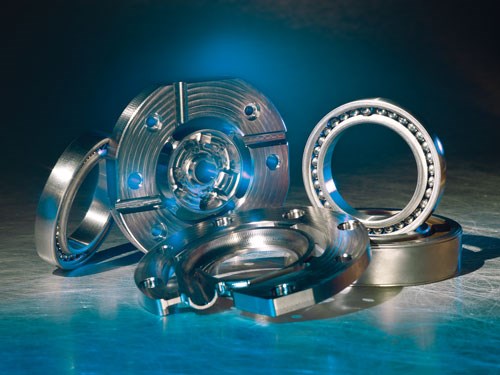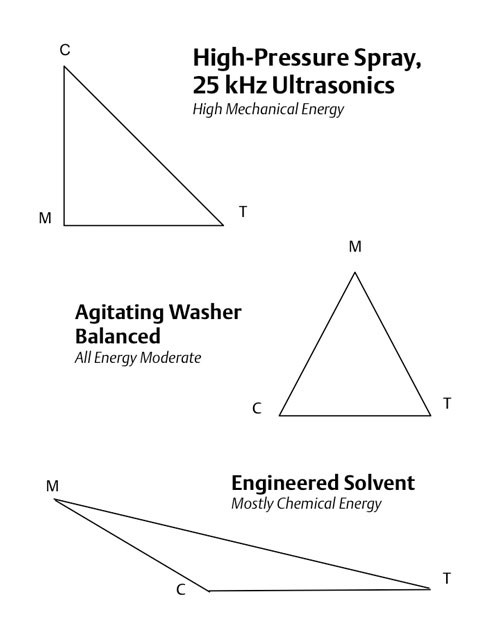The Cleaning Process and Equipment Relationship
Objective must be identified, followed by development of a process.
Anyone responsible for the implementation of a cleaning step within a manufacturing operation should understand the relationship between the cleaning process and the cleaning equipment. Though the two are different entities, they form a necessary symbiotic relationship. If either component fails to perform, the entire operation fails. On too many occasions, an engineer might assume that a standard cleaning system configuration will get the job done, only to be disappointed that it doesn’t meet expectations. The process cleans the parts and the equipment delivers that process; the two elements cannot perform independently.
Cleaning is simply filling and draining, or wetting and evacuating a part’s surface. Whether the process is aqueous or solvent, the active mechanisms involve wetting the target surface with chemistry, acting upon that surface and evacuating the byproduct of the interaction.
The cleaning objective must first be identified, followed by the development of a process that consistently meets this objective. Without an effective process, there is little need for equipment.
Science comes into play while determining when, how often and what to fill or wet with, the actions taken while it is filled and how to remove the resulting soil. The data from measuring cleanliness defines the process. The balance of the operation depends upon the equipment to deliver the correct process.
| Checklist for Cleaning Process Evaluation |
|
By understanding the fundamentals of what it takes to clean parts, the buyer can confidently evaluate the equipment delivering those mechanisms to achieve the cleaning objective:
|
The now mature concept of the Cleaning Triangle, with temporal and energy components, more precisely defines the process. Chemical, thermal and mechanical energies, along with exposure time to this set of parameters, constitutes the cleaning process itself. Chemical and thermal aspects are chosen depending on the scope of the performed work. A cleaning compound may be used to condition the soil for easier removal, while an alternate compound might be used to address the soil and modify a metal surface (cleaning and finishing in a one process step). The addition of mechanical energy serves to not only accelerate the interaction, but also serves as a process delivery mechanism (agitation/flushing to liberate entrapped air).

Complex parts require equipment to manipulate a workload orientation to enable passive process delivery, or alternatively, to deliver process much more precisely with active delivery.
Passive
Proper part orientation is essential for passive process delivery. Optimal orientation of the part enables filling and draining with no workload manipulation or external mechanisms. Gravity is an important component, as well as the influence of attractive forces interacting to facilitate filling and draining. Immersing a vertically-oriented piece of pipe is a good example, as filling and draining occur freely.
In cases where part geometry calls for fill/drain on various axes, the workload must be manipulated (rotation, tipping, agitation and so on) to overcome the physical behaviors that keep air entrapped or liquids in place. Although the workload is actively manipulated, the process is still highly dependent on the passive mechanisms.
Workload manipulation is frequently used to passively deliver processes, differing from active process delivery by presenting the parts to the process. Batch processing in a rack or basket requires manipulation of the entire workload.
Active
Individual workpiece handling provides flexibility where the actual process can be precisely delivered to specific areas of the part. This is classified as active process delivery, which delivers the process directly to the parts, overcoming the elements associated with passive delivery. An example is a horizontal piece of pipe flushed out with the pressure of a garden hose.
With individual part flow, the process acts directly upon the part’s fixed orientation, rather than a batch workload subjected to the process. Active displacement of entrapped air can take place through flushing mechanisms. Likewise, active evacuation can flush out soils and blow out rinse water. Pressurized air could be the sole drying mechanism, or a blowout followed by hot forced air for final drying. The part moves in a linear fashion through these process mechanisms.
A hybrid scheme would move a batch of racked parts through the process, like a conveyorized spray or immersion washer, for example. Properly oriented parts would travel through various process zones (wash, rinse, dry). The equipment delivers the process to the entire workload, but not as precisely as if parts were handled individually. Focusing process on the critical areas of an individual part would be more efficient than a larger batch. The combination of the cleaning objective and the desired material handling creates what the machine/process will ultimately look like.

Mechanical (M), thermal (T) and chemical (C) energies are employed and exploited as necessary for effective cleaning. High Mechanical energy is used for particle removal and surface modification. Chemical emphasis is the backbone of a solvent process. Balanced component levels are typical when all elements are used at moderate levels.
Interdependence
The equipment must deliver, maintain and support these established process parameters to achieve a reliable and repeatable cleaning objective. A cleaning system can have multifaceted functions, such as the transport of workloads through the process/machine and process maintenance. Examples of equipment process maintenance include cleaning compound concentration monitoring/control, rinse water quality monitoring/control, wash tank oil removal, an outboard reflux still, filtration monitoring/control and data acquisition in support of statistical process control. The equipment must work together to maintain the process.
The manufacturing engineer must pay close attention to detail and have a good understanding of the process mechanisms that precede design of equipment configuration. Is process delivery precise enough? An application may require flushing to actively fill a part, but the flushing mechanism must also target the area of the part that needs to be evacuated. On the other hand, perhaps a simple spray would suffice. Cost, complexity and performance are factors to consider.
Shortcuts exist where a mature configuration might permit skipping the process development stage, but the result must be proven. A properly designed spray washer that cleans plumbing fittings will most likely be able to clean similar parts. An ultrasonic system that cleans orthopedic implants might also be effective with newly-designed implants. Regardless of this overlapping utility, very minor part differences can be cause to modify these tried-and-true machine designs.
Looking Forward
Flexibility in the process brings distinct advantages with respect to equipment design. A process may be proven for a particular application, but it is best if it can also be effective with part design changes or future adjustments in upstream manufacturing activity. Does the relocation of a blind hole present complications while filling/draining a part? Does an increase in production rate impose undue stress on a machine’s ability to remove oil from a wash tank? Changes such as moving from oil- to water-based machining fluids can have a profound effect, so potential production process modifications need to be considered.
J. Brian Keene is worldwide cleaning technology manager at Branson Ultrasonics Corp., a business of Emerson Industrial Automation. For information, call 203-796-0400 or visit bransonultrasonics.com.
Originally published in the March 2016 issue.
Related Content
Improving Wastewater Management Efficiency
Don’t find yourself underwater when managing wastewater processes. Follow these steps to improve efficiency and determine the best ROI.
Read MoreAdvantages to Pumped Eductor Agitation
Not all agitation methods are created equally. Pumped agitation with eductor nozzles can improve process tanks and quickly show a reduction in operating costs while keeping staff safe, following environmental legislation and preventing pollution.
Read MoreCorrosion Resistance Testing for Powder Coating
Salt spray can be useful to help compare different pretreatment methods and coatings but it does not tell us much about the corrosion resistance of a part over time in the field. Powder coating expert Rodger Talbert offers insights into how to get a better idea of how to improve a part’s corrosion resistance in the real world.
Read MoreClean Technology Lasers for Coating Adhesion
Laser cleaning systems remove corrosion, grease, residue and existing coatings from metal surfaces quickly, with less preparation and mess than traditional techniques.
Read MoreRead Next
Education Bringing Cleaning to Machining
Debuting new speakers and cleaning technology content during this half-day workshop co-located with IMTS 2024.
Read MoreDelivering Increased Benefits to Greenhouse Films
Baystar's Borstar technology is helping customers deliver better, more reliable production methods to greenhouse agriculture.
Read MoreA ‘Clean’ Agenda Offers Unique Presentations in Chicago
The 2024 Parts Cleaning Conference, co-located with the International Manufacturing Technology Show, includes presentations by several speakers who are new to the conference and topics that have not been covered in past editions of this event.
Read More





















